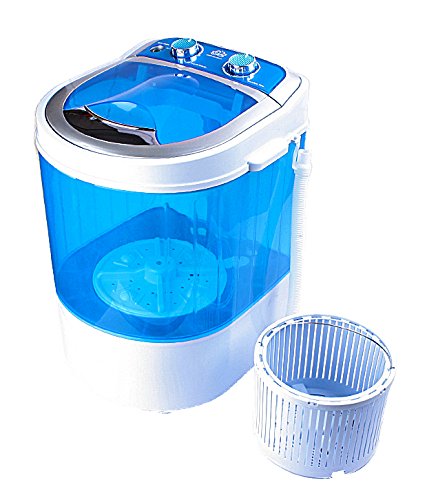A portable washing machine is a compact appliance designed for washing in small spaces or while on the go. It is smaller than regular washers, hence fitting well in apartments, RVs, and even camping. Portable washers are easily mobile, connecting to most faucets to intake water and using generally less water than full-sized machines. They have basic wash cycles and are electricity-powered, although some models have provisions for manual operation. They, in general, make for really handy laundry solutions where space and portability are concerned.
Size and Portability.
These are the two features that make portable washing machines different from traditional washing machines:
- Portable Design: Comparatively, portable washing machines are smaller versions of the standard washers. Mostly available from 1 to 2.5 cubic feet in capacity, they are best suited to small apartments, RVs, boats, and can be used as camping machines.
- Lightweight Construction: These washers are deliberately designed to be lightweight so that they can be easily carried. They often weigh between 40 to 80 pounds, meaning it’s possible to move them around single-handedly without extra help.
- Easy Storage: Portable washers are compact in size and can easily be kept in small closets, under sinks, or in tight spaces when not in use. This makes them ideal in areas where space is limited and flexibility is required.
- Portability Features: Most of the portable washing machines are provided with handles or wheels for easy mobility. In this manner, the washer can be easily moved from one place to another, either it be inside a house or from one house to another.
- On-The-Go Use: Some models are designed specifically for travel or outdoor usage. Those dimensions become even more compact, and the device is generally built in order to be more resistant to transportation and environmental changes.
- Flexibility in Installation: Whereas most of the conventional washers do have fixed plumbing connections, a majority of the portable washers, on the other hand, usually hook up to most standard kinds of faucets with a hose for water intake. Because of that, their installation is rather easy, and they can be attached to what kinds of faucets, normally found within the homestead or within any temporary living quarters.
- Versatility: Compact in size, portable washers are, most of the time, equipped with a range of wash cycles and settings that differ not too much from other larger models, hence providing the users some levels of flexibility in due course of attending to different types of fabrics and laundry loads.
In conclusion, the size and portability of the washing machine makes it very feasible for either anybody residing in cramped apartments or more practical for that matter when used as a multifunctional laundry solution that can be easily moved and stored after use.
Capacity.
Capacity is one of the major factors in portable washing machines, describing the amount of laundry that can be washed in every cycle. Most portable washing machines will fall between 1 and 2.5 cubic feet in capacity, which translates to a load of laundry of about 5-15 pounds.
- Suitability for Small Loads: Compact in size, portable washers are really meant for small loads of laundry. They become a perfect appliance for singles, couples, or small families who want to wash a fair amount of clothes and linens without the heft of a full-sized washer.
- Efficiency: While portable washers have a much smaller capacity, they are efficient in terms of water usage all the same. They also consume lesser water per load when compared to traditional washers. This can be advantageous in an environment with limited availability of water or when one wants to save money on utilities.
- Variation of Load Types: Portable washers can wash a wide range of fabric types and a whole range of soil levels, offering different wash cycles—like normal, gentle, heavy-duty—like bigger machines. This ensures users can clean effectively from light garments to heavy-duty things.
- Specialty Practicality: The moderate capacity of a portable washer makes it practical for special uses, such as washing baby clothes, workout gear, or things that need to be cleaned often but do not warrant a full-sized load.
- User Considerations: In portable washers, the capacity should be determined by usual use or needs of users. If one does frequent washing of big items, like comforters or bulk fabrics, then the smaller capacity may get a bit limiting, and one might need to use other laundry facilities to do so.
Conclusion: Even while offering less capacity compared with conventional washers, portable washing machines bring a practical and efficient solution to laundry for singles and small households in situations demanding high space and mobility.
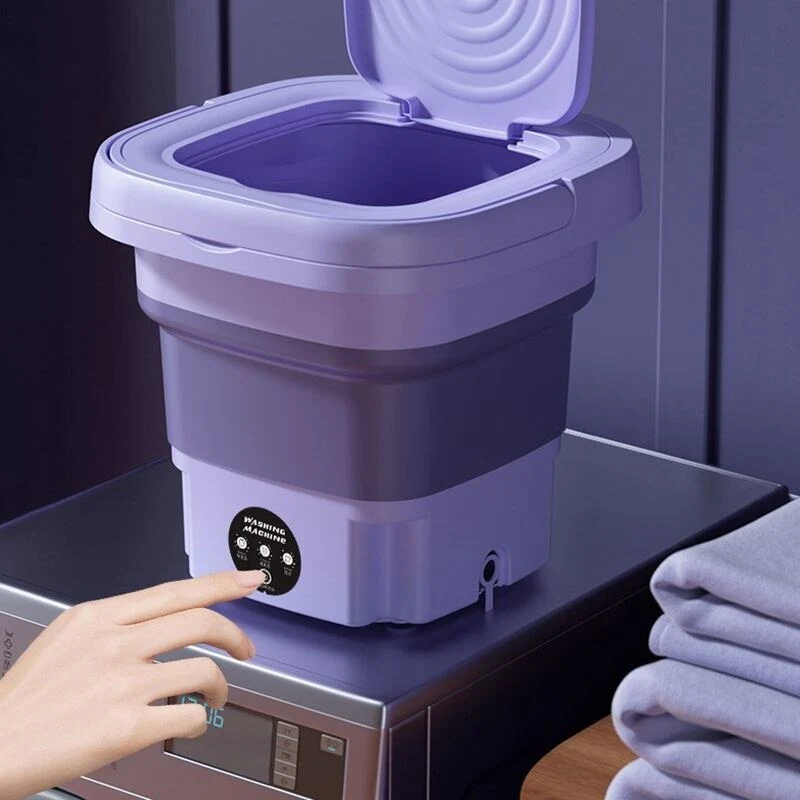
Functionality.
Functionality is another core element in portable washing machines, as it deals with what they can do and what sets them apart. The aspect of loading and operation varies, although most portable washers are top-loading, such that users can add and remove their laundry at the top of the machine. The design is simple, easy to operate, and familiar with traditional washers.
- Wash Cycles: Portable washing machines generally come with a range of wash cycles to care for a wide array of fabrics and different degrees of soiling. The most common cycles are the normal, gentle, and heavy-duty cycles. Some models can have such special cycles as Quick Wash or Soak Cycles.
- Water Temperature and Levels: Many portable washers allow users to adjust the water temperature and water levels according to their preference or the requirement of the laundry to be washed. This flexibility will ensure optimal cleaning performance while at the same time saving precious water.
- Agitation and Cleaning Mechanism: Portable washers make use of some alternative cleaning mechanisms, such as agitator or pulsator, which shall provide enough agitation force to the clothes to get them rid of dirt and stains. These mechanisms ensure thorough cleaning without the need for a central agitator column, thus saving on space and reduction in the weight of the machine.
- Spin Cycle: The majority of portable washers include a spin cycle that extracts excess water from the clothes after the cycle, hence reducing drying time and leaving clothes from the washer not very wet.
- Control Panel and Settings: The control panel of portable washing machines is usually user-friendly with buttons or dials for selecting wash cycles and setting most other options using a single key or button on the interface to start or pause the machine accordingly.
- Energy Efficiency: A majority of portable washers are made to be energy efficient, using less electricity compared to full-sized washers. That translates into potential long-term savings for many users who tend to do smaller washes quite frequently.
- Noise Level: Generally, most portable washers create a medium amount of noise while running. Most manufacturers integrate noise reduction features so as not to cause any disturbance; hence, these products should work fine in apartments or other shared living spaces.
- Durability/Maintenance: A portable washing machine is made to last with low maintenance required. Cleaning the filters regularly and ensuring the hoses are tightened usually suffice to keep one in tip-top shape.
- Other features: Higher models might feature delay start timers, digital displays, child locks, and automatic detergent dispensers. All of these make the machines a lot more convenient and user-friendly.
Thus, portable washing machines symbolize a range of functionality attributes that make them very practical for singles or small households in search of compact and effective laundry. It is their versatility in wash cycles, user-friendliness, and energy efficiency that explains their wide application in different living conditions.
Water Usage.
Water Usage This is a vital factor of consideration when assessing portable washing machines. Efficient water consumption is vital for environmental as well as practical reasons:
- Water Consumption: Portable washing machines use less water per cycle compared to their full-sized counterparts. This is achieved through several design features such as a smaller tub and water flow mechanisms.
- Capacity Compared to Water Use: An aspect regarding portable washers that is very efficient is water use-even at a lower capacity than regular washing machines. Depending on the washer model and wash settings, it will typically use between 6 and 16 gallons of water per cycle.
- Adjustable Water Levels: Most of such washers have a provision where the user can adjust the water levels based on the size of the load being washes. This kind of flexibility ensures that the washer is not using more water volume than it ought to, making its efficiency in water usage even better.
- Energy Star Ratings: There are some ratings for such portable washing machines separately under the Energy Star category; a machine gets rated according to the set rigorous guidelines on energy efficiency by the Environmental Protection Agency. Energy Star-rated models use less water and, most importantly, use less energy, which saves on costs and lowers the environmental impact.
- Ecological Impact: The low water consumption of portable washers enables more conservation of natural resources and more attempts to reduce the ecological footprint created in consequence of laundering items; this is highly important when water preservation becomes equally crucial.
- Practical Benefits: In this regard, users of portable washers enjoy lower water charges or home expenses, especially in the context of metering and constrained water availability.
- Water Inlet and Drainage: Most portable washers obtain water for intake from a regular faucet with the use of a hose. They drain water out of the washing machine with another hose, which one can aim at any sink, bathtub, or other facility for drainage. Through this design, it ensures that there is no wastage of water in any means during the wash.
In other words, the portable washer machine is intentionally made to utilize the resource effectively and, therefore, be a practical way of saving the environment from washing clothes. What makes them practical is their ability to optimize water usage yet deliver on cleaning; thus, they are viable for people with low impact and frequent washing needs.
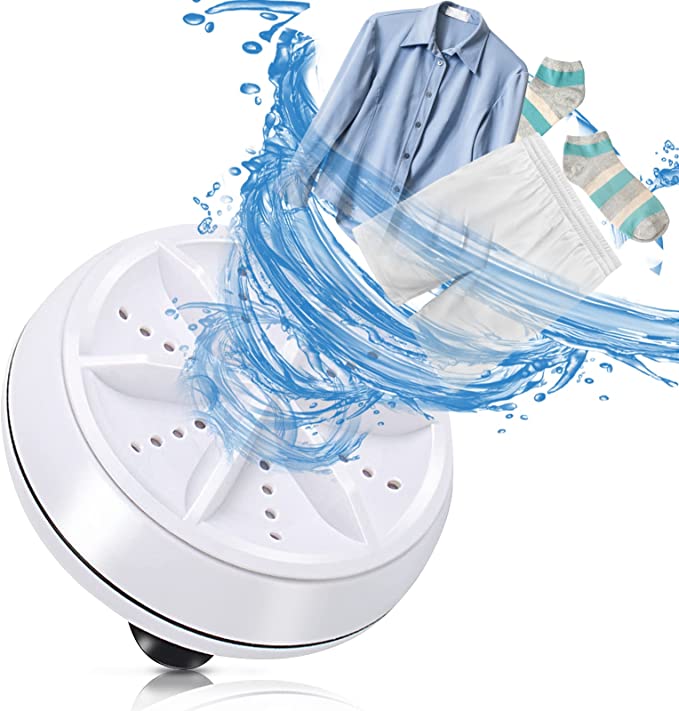
Power Requirements.
Power Requirements for Portable Washing Machines When considering portable washing machines, you should know the electrical requirements and operational considerations that need to be met in order for them to work.
- Electrical Compatibility: The majority of portable washing machines work with standard house voltage, which is 120 volts AC in North America and 220-240 volts AC in most of the rest of the world. The exact voltage and electrical requirements must be checked on each model to ensure that it matches with available power outlets at a location.
- Plug Types: Depending on the country of origin of the portable washer or where it is being sold, several types of plugs may be fitted. This may call for adapters or converters if the plug doesn’t fit into your home or location outlets.
- Power Consumption: Generally, all portable washers are fabricated in such a way that they are power-friendly, which means they consume less electricity in comparison with full-sized washers. This efficiency is good for saving energy bills while at the same time saving the environment.
- Operational Settings: Some portable washing machines offer the user options to adjust their overall power consumption. Examples include lower power settings in certain models and alternative power sources like battery and manual for off-grid or outdoor applications.
- Safety Features: Portable washers are fitted with electrical safety features against electrical shock, such as GFCIs or surge protection within the power cord. These features ensure that it is safely operated during use.
- Installations and Configurations: Setting up a portable washer is easy. You only have to plug the appliance into any standard electrical outlet that can hold its voltage requirement. Be careful not to put too much electrical demand on the circuit at the outlet from the washer.
- Power Cord Length: The length of the power cord of the portable washer varies by model. Consider how far away you expect the electrical outlet to be from the point where the washer will be installed, so that the cord can reach comfortably without the risk associated with potentially dangerous extension cords.
- Power Consumption at Work: Generally, portable washing machines consume a different amount of power, which may be based on the cycle used and settings chosen. There are specifications provided by the manufacturers on power consumption, hence estimating the energy cost of running a washer.
Knowing the power requirement of a portable washing machine is relevant for the various needs of electrical outlets, safe operations, and efficient energy usage. Manufacturers provide detailed specifications that guide a consumer on picking and fitting the right washer with the appropriate needs and location.
Installation.
The Portable Washing Machine Installation has several steps in the process for setting it up and for its proper functionality.
- Location Selection: Choose an appropriate location for the Portable Washing Machine in an easily accessible place with a standard electrical outlet and a faucet for drawing water. Proximity to sinks, bathtubs, or any other drainage options is also highly advisable.
- Electrical Requirements: Check whether the electricity outlet you are to use will be able to support the voltage and plug type of your portable washer. Always plug the washer in a grounded outlet to prevent electrical shock and risk-free operation.
- Water Connection: Most portable washers connect to a regular faucet with a hose that comes with the washer. Attach one end to the faucet and another to the inlet valve on your washer. Be sure to secure the connection tightly to avoid leakage while running.
- Drainage Set-up: The drainage hose has to be positioned in such a way that it can easily reach a sink, bathtub, or any other drainage outlet without any encumbrance. Secure the hose from all possible aspects so that during the motion in the wash cycle, it doesn’t spill on the floor from the water.
- Leveling: Portable washing machines should be leveled to ensure appropriate functioning with reduced noise and vibration. Leveling feet or pads at the bottom of the washer should be adjusted if necessary to help stabilize it on the floor.
- Safety Considerations: Put the washer on a stable and even surface so that it will not tip while in use. Give enough ventilation around the washer to assure adequate air flow to prevent overheating.
- Test: Once installation is complete, test the washer with a test cycle to ensure all is well with how it’s working. Run a small load through a wash and spin cycle to check for leaks, drainage, and general performance.
- User Manual: Use the installation instructions as indicated in the owner’s manual provided by the manufacturer, and follow any additional recommendations or requirements particular to your model of portable washing machine.
- Maintenance: Check the condition of connections, hoses, and the drainage system on a regular basis for any signs of wear or leakage. Keep the filters and other units clean, and maintain them in accordance with the manufacturer’s recommendations, to provide the best and long-lasting performance for a portable washer.
By this installation guide, users can easily install a portable washing machine at a preferred site and make sure that it is running safely and efficiently for better laundry of clothes and linens.
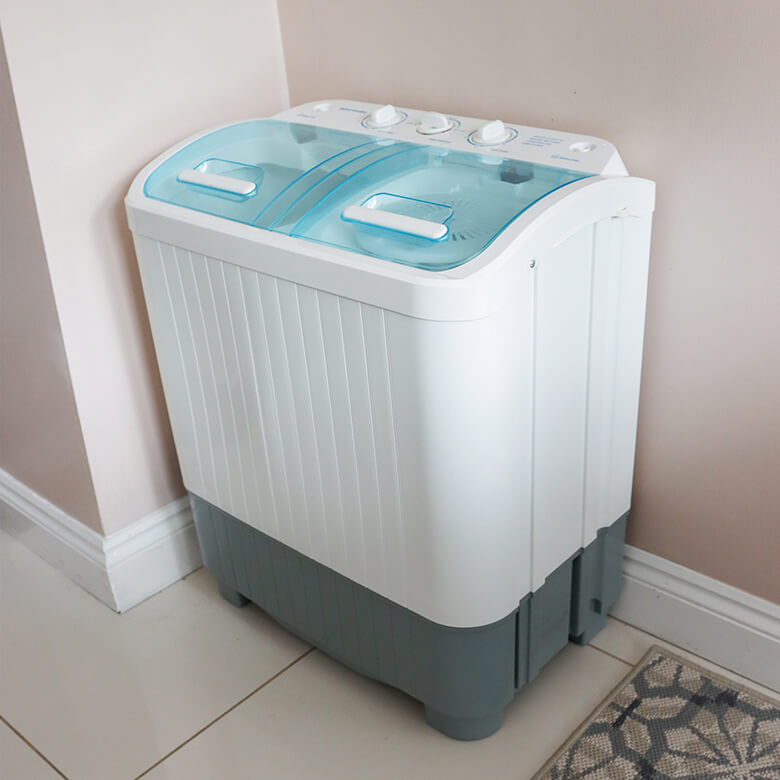
Cost and Efficiency.
It considers dealing with portable washing machines: cost and efficiency.
- Initial Cost: In general, portable washing machines are more wallet-friendly compared to their full-size siblings. They should be competitively priced because they are used only for a single person or small household. The prices go according to brand, capacity, features, and quality—$150 to $400 USD.
- Operating Costs: Most portable washers are generally more energy efficient than most washers; they use fewer watts per load. This will usually amount to a significantly lower power consumption bill after some time, mainly for those who do smaller loads habitually or use energy-saving modes.
- Water Usage: Because portable washers are designed to be water-efficient, they use less water per load compared with the full-sized washers. The efficacy in this factor not only saves water but also reduces the impact on the environment from laundry operations.
- Energy Efficiency Ratings: Some of the portable washing machines are Energy Star rated. This is an indication that the product has passed the strict energy efficiency laid down by the agencies. Energy Star-rated models demonstrate lower consumption of energy during running time and thus provide higher cost savings and help save the environment too.
- Maintenance Costs: By and large, portable washers are much easier to maintain than their larger and more complicated cousins. Scheduled maintenance tasks include cleaning filters and checking on hose connections to ensure the appliance works efficiently and for a long time.
- Long-Term Operating Life and Durability: Portable washing machines are more affordable upfront, but their lifespan and durability may vary significantly based on how they are used and what kind of maintenance is performed. Opting for a better brand known for the sturdiness of its products could possibly lengthen its operational life with lower repair costs.
- Comparative Analysis: Comparing the various models of portable washing machines based on cost and efficiency by viewing the operating costs, energy consumption ratings, water usage, and user reviews will help a consumer make an informed decision regarding the choice that will best suit his or her budget and meet his or her specific laundry needs.
- Return on Investment: Any person who wants to get a positive return on investment, seeking practicality, and saving space when doing their laundry will find portable washing machines very affordable, efficient, and convenient. The cost savings in energy and water consumed counteract the price paid upfront over some time.
Maintenance.
Maintenance for portable washing machines involves regular care for optimum performance and a long life. Key tasks include:
- Cleaning Filters: Most portable washers come with lint filters or mesh screens that you need to clean regularly. Remove accumulated lint or other debris to prevent clogs and ensure efficient draining of water.
- Hose: Check the inlet and drainage hoses periodically for leakage, cracks, or blockages. Make sure the hoses are properly fitted over the faucets and the outlets so as not to spill water all over during performance.
- Interior Drum Cleaning: Clean the interior drum of the washer periodically to prevent debris accumulation, which adversely impacts cleaning performance. Mild detergent/water solution; clean and wash out well.
- Seal and Gasket Maintenance: Check whether the door seals or the lid have any visible wear or development of mold. Cleaning seals, regularly, with a damp cloth and mild soap will help prevent mold and assure a tight seal when operational.
- Exterior Cleaning: Clean dust, dirt, and spills off of the exterior washer surface by using a slightly wet cloth. Avoid cleaning products that are abrasive and corrosive.
- Ventilation: Provide adequate ventilation space around the washer to avoid overheating. Vents and air intake areas should be kept clean of dust or blockages.
- Leveling and Stability: Periodically check the leveling of the washer to ensure the stability of its operation. Leveling feet or pads should be adjusted if there is excessive vibration or noise when in operation.
- Drain Pump Maintenance: If your washer has a drain pump or filter, clean according to the manufacturer’s instructions so that it can drain properly and dislodge all particles.
- Use It: Running the washer regularly—even if only a cycle with a rinse—cleans out the inside of the elements, keeping them in good order. Otherwise, stagnant water may remain within, and detergent settlement happens.
- User Manual: Check for specific guidelines and recommendations in the user manual from the manufacturer for maintaining your portable washing machine model.
By putting these tips into practice, maintenance will extend the life of a portable washing machine in continuous service, laundering clothes and linens, and assure years of reliable performance to the owner. This also ensures that not only costly repairs are prevented, but energy and water efficiency is sustained over some time.
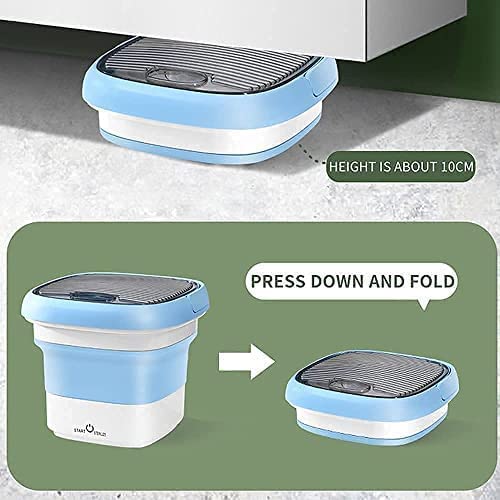
Additional Features.
Besides, additional features in portable washing machines enhance convenience, efficiency, and user experience for the appliances. Some of them come with:
- Digital Controls: Digital control panels with settings that provide exact control over wash cycles, water temperature, spin speed, and delay start timers facilitate customized laundry care in relation to fabric types or personal preference.
- Variety of Wash Programs: Advanced portable washers will have a variety of wash programs to include normal, quick wash, delicate, heavy-duty, and many others. All these programs may be used with different types of fabrics or due to the varying degrees of dirt in the cloth to get the perfect wash.
- Automatic Dispensers: Some of them have built-in automatic detergent and fabric softener dispensers. These dispensers release precisely the right amount of detergent during the appropriate point in the wash cycle to ensure effectiveness and ease of cleaning.
- Adjustable Water Levels: Certain portable washers allow users to adjust water levels according to the size of the load to be washed. This feature saves water and resources effectively without compromising on cleaning performance.
- Quiet Operation: Noise reduction technologies are integrated into the machines by the manufacturers to minimize the noise while in operation—wash and spin. This feature is especially useful when living in apartments or shared spaces where noise levels may be an issue.
- Compact Design: To save space, portable washers are compact in design and lightweight in construction, making it easy to move about and store in small living quarters such as apartments, RVs, or dorms.
- Spin-Dry Function: Some portable washers have a spin-dry function that wrings extra water out of the clothes at the end of their cycle, making them dry faster, either to air-dry or when a compact dryer is needed.
- Child Lock: Some models have a child lock to lock against unintended operation or changes to settings for complete peace of mind where small children are concerned.
- Portable Design: Most portable washers include handles or are mounted on wheels for easy movement. This feature of the washer allows it to be easily moved from one room to another or even to different locations, thus making the chore of laundry more convenient and hassle-free.
- Energy Efficiency: Energy-efficient models optimize power consumption during operation, thereby reducing electricity costs and environmental impact. Look for Energy Star certified portable washers that meet rigid energy efficiency guidelines.
- Stainless Steel Drum: An upper-class model may include a stainless steel drum. That will make it more robust to rust and less inclined to smell than plastic drums. Moreover, it provides better cleaning and more gentle treatment of fabrics.
- Smart Connectivity: Some of the new portable washers come equipped with smart connectivity, allowing users to control and monitor laundry cycles remotely via a smartphone app. It brings ease and usability in smart home environments.
Added features that provide more functionality, efficiency, and friendliness to users make up a portable washing machine to attend to various preferences and household needs among its users. Thus, buyers would want to consider, based on laundry habits and living conditions, which features best work with each individual so as to enjoy greater convenience and satisfaction in using a portable washer.
User Considerations.
User factors relating to portable washing machines include what will influence the ease of use, performance, and satisfaction of the system as a whole. They are:
- Capacity: Check the washer’s capacity so that the solution is able to meet the current or prospective laundry demands. Most portable washers are used for smaller loads than full-sized washers, making it suitable for singles, couples, and small families.
- Space and Storage: Consider the size of the portable washer with respect to available space where you live. Ensure that there is enough space to operate and store it when you’re not using it.
- Portability: Check the weight and design features, such as handles or wheels, to aid in easy transporting. This would be especially useful in case you would want to move the washer between rooms or apartments, or even use it at varying places, like RVs and campsites.
- Power and Water Requirements: Make sure the machine is compatible with your house’s electrical outlets and faucet connections. Check if the washer’s power and water consumption are within the reach of your utilities and environmental concerns.
- Noise Levels: Think about the noise levels during both the wash and spin cycles if you live in close quarters or shared spaces where quiet operation is preferred. Look for noise-reducing features on models if noise is a concern to you.
- Wash Programs and Settings: Check how many wash programs are available and what settings can be found on the washer. It should have different options for various fabric types, soil levels, and customizable settings that allow one to adjust based on personal laundry needs.
- Energy Efficiency: Go for energy-efficient models to reduce electricity consumption and save utility bills in the long term. Look out for the Energy Star certification or any other rating indicating that the washer passes strict standards in energy efficiency.
- Maintenance Requirements: Check maintenance tasks like cleaning filters, checking hoses, or providing adequate ventilation from the manufacturer’s recommendations. Select a washer that best fits your willingness and ability to keep up with regular maintenance.
- Durability and Build Quality: Check on the construction material and general build quality. Look for things like stainless-steel drums or sturdy plastic components that may improve its durability and longevity.
- User Reviews and Ratings: User reviews and ratings provide information about model reliability and performance other than general customers’ satisfaction. Such feedback regarding ease of use, reliability, and customer support will greatly influence your choice.
- Cost and Value: Consider the price at purchase and what its long-term value is in respect to efficiency, durability, and features. Compare a few models to get the best overall cost-to-functionality ratio that will suit your needs.
Having these considerations of the user in mind will help in selecting a portable washing machine that can serve specific needs, making doing laundry convenient, efficient, and effective.
